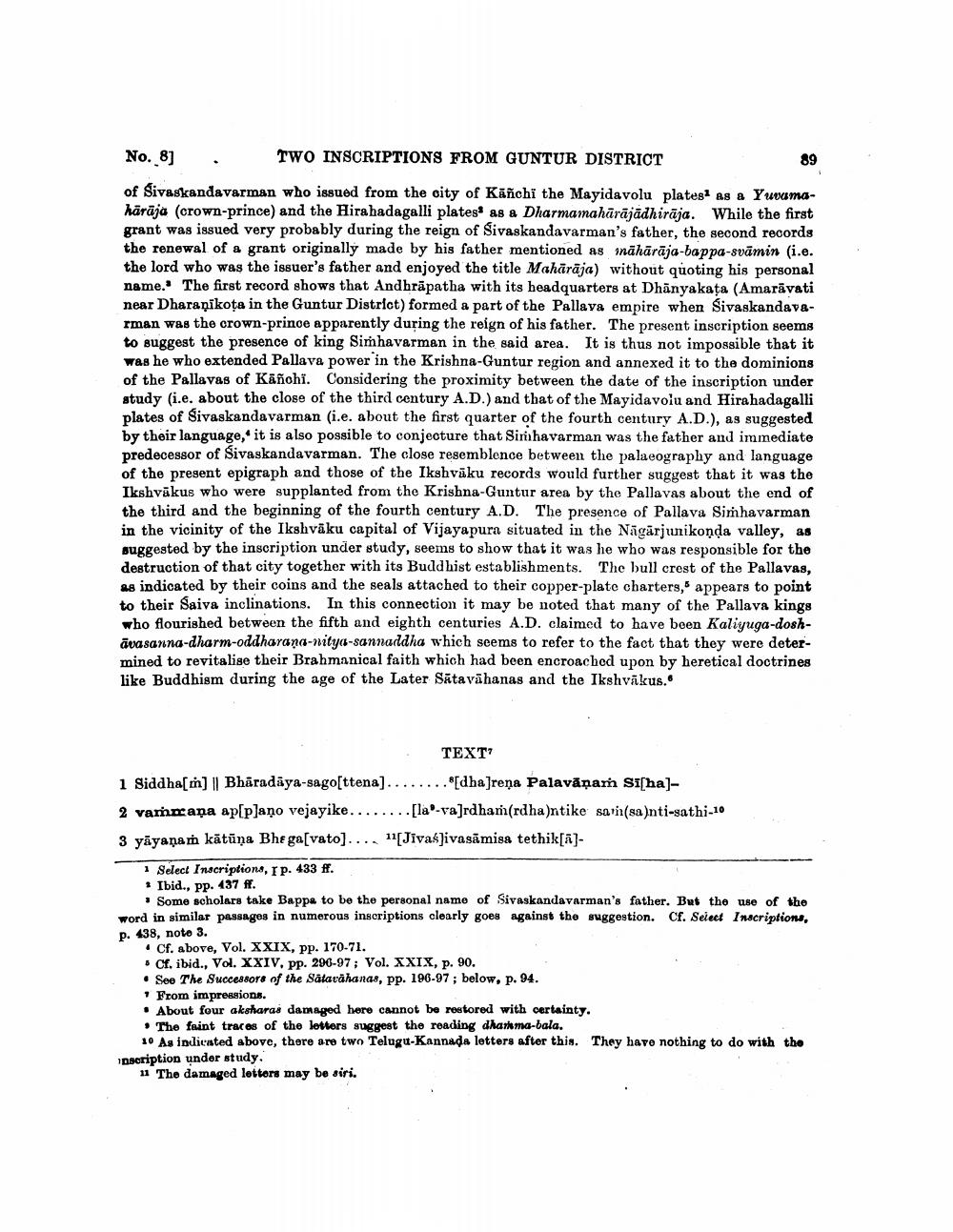________________
No. 8]
TWO INSCRIPTIONS FROM GUNTUR DISTRICT
of Sivaskandavarman who issued from the city of Kanchi the Mayidavolu plates as a Yuvamahārāja (crown-prince) and the Hirahadagalli plates as a Dharmamahārājādhiraja. While the first grant was issued very probably during the reign of Sivaskandavarman's father, the second records the renewal of a grant originally made by his father mentioned as māhārāja-bappa-svamin (i.e. the lord who was the issuer's father and enjoyed the title Mahārāja) without quoting his personal name. The first record shows that Andhrapatha with its headquarters at Dhanyakata (Amaravati near Dharanikota in the Guntur District) formed a part of the Pallava empire when Sivaskandavarman was the crown-prince apparently during the reign of his father. The present inscription seems to suggest the presence of king Simhavarman in the said area. It is thus not impossible that it was he who extended Pallava power in the Krishna-Guntur region and annexed it to the dominions of the Pallavas of Kañchi. Considering the proximity between the date of the inscription under study (i.e. about the close of the third century A.D.) and that of the Mayidavolu and Hirahadagalli plates of Sivaskandavarman (i.e. about the first quarter of the fourth century A.D.), as suggested by their language, it is also possible to conjecture that Sirihavarman was the father and immediate predecessor of Sivaskandavarman. The close resemblence between the palaeography and language of the present epigraph and those of the Ikshvaku records would further suggest that it was the Ikshvākus who were supplanted from the Krishna-Guntur area by the Pallavas about the end of the third and the beginning of the fourth century A.D. The presence of Pallava Simhavarman in the vicinity of the Ikshvaku capital of Vijayapura situated in the Nagarjunikonda valley, as suggested by the inscription under study, seems to show that it was he who was responsible for the destruction of that city together with its Buddhist establishments. The bull crest of the Pallavas, as indicated by their coins and the seals attached to their copper-plate charters, appears to point to their Saiva inclinations. In this connection it may be noted that many of the Pallava kings who flourished between the fifth and eighth centuries A.D. claimed to have been Kaliyuga-doshavasanna-dharm-oddharana-nitya-sannaddha which seems to refer to the fact that they were determined to revitalise their Brahmanical faith which had been encroached upon by heretical doctrines like Buddhism during the age of the Later Satavahanas and the Ikshvākus.
89
TEXT?
1 Siddha[m] || Bharadaya-sago[ttena].
...[dha]rena Palavāṇam Si[ha]
2 vammaņa ap[plano vejayike........ [la -va]rdham (rdha)ntike san(sa)nti-sathi-10
3 yāyaṇaṁ kātūṇa Bhɛ ga[vato]... "[Jivaś]ivasāmisa tethik[ā]
1 Select Inscriptions, I p. 433 ff.
Ibid., pp. 437 ff.
Some scholars take Bappa to be the personal name of Sivaskandavarman's father. But the use of the word in similar passages in numerous inscriptions clearly goes against the suggestion. Cf. Select Inscriptions, p. 438, note 3.
Cf. above, Vol. XXIX, pp. 170-71.
Cf. ibid., Vol. XXIV, pp. 296-97; Vol. XXIX, p. 90.
• See The Successors of the Satavahanas, pp. 196-97; below, p. 94.
From impressions.
About four aksharas damaged here cannot be restored with certainty.
The faint traces of the letters suggest the reading dhamma-bala.
10 As indicated above, there are two Telugu-Kannada letters after this. They have nothing to do with the Inscription under study.
11 The damaged letters may be siri.




